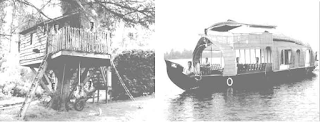A. Look at the pictures and answer these questions.
1 What do the people do in a tree or a boat?
2 Why do they do so?
B. Discuss what will be our problems if our population becomes double the size it is now.
C. Read what the teacher Ms Choudhury and her students are talking about.
The class comes up with different problems. One group leader says, "The scarcity of food will be a serious problem in the years ahead. It is true that our agriculturists have developed new varieties of rice and its per acre production has definitely increased. But the rate of increase in food production cannot keep pace with the rate of population growth. This is because our land is fixed, i.e. we cannot increase it, while our population is increasing rapidly."
Another group leader comes up with the housing problem in the country, which he says adds much to the food problem. He says, "Families are growing larger in size and at the same time breaking into smaller families. Each smaller family needs a separate house to live in. Also the arable fields are being divided by these smaller families among themselves. Mills and factories are being set up, which occupy a considerable portion of our land. So while we need more land to grow more food to feed more mouths, our land is shrinking day by day. If our population grows at the present rate, a day will come when many people will not find any land to build a house on. And, as a result, many of them might live on trees or on the floating boats in the rivers."
"No way," another student argues. "Trees are being cut, hills are being cleared and water bodies are being filled up — all to meet the needs of too many people."
"Thank you students," Ms Choudhury says, "You're quite right. Let me tell you about this village where I was born and brought up. Things were not like this in the past. I remember as a child, the village was so beautiful! The green paddy fields and yellow mustard fields seemed to be unending. They used to wave and dance in the breeze. There used to be a wood in the northern side of the village. There was a tall tamarind tree in the middle of the wood. Also there was a big banyan tree which looked like a huge green umbrella, with its aerial roots hanging down. I often used to go there with my friends. We would often have picnic there. While the boys would climb the tamarind tree and pick some tamarinds, I and my best friend Rima used to swing from the hanging roots. But now, look, the wood is gone. The beauty of the crop fields is spoiled by the unplanned houses built here and there."
D. Tick the best answer.
1. The rate of increase in food production cannot keep pace with the rate of population growth.
The sentence means that the food production
a is as much as needed,
b is less than what is needed,
c is more than what is needed,
d is sufficient for the population.
2. How can our housing problem add to our food problem?
a After making houses, farmers do not have enough time to work in the field.
b After making houses, farmers do not have enough money to buy food.
c If you do not have a house, you cannot store your food,
d For making too many houses, people are using the crop land.
3. What makes our land shrink day by day mentioned in line no. 13?
a Families are growing larger in size.
b Houses and factories are being built on it.
c Smaller families need smaller houses.
d Land grabbers are occupying portions of our land.
4. Many people may have to live on trees, because
a they would like tree houses,
b making houses on trees is less expensive,
c they may not find land to make houses,
d tree houses are safer during floods.
5. People are cutting trees to
a plant more trees.
b keep the environment clean,
c make articles of furniture,
d grow crops or make houses.
E. Make a list of things Ms Choudhury saw as a child in the village. Why do you think she liked them?
F. Write a composition about your village or locality. Describe any change in the things you have noticed over the years, such as houses, fields, trees, plants, etc.
If you want to read the next lesson of this unit please click the link below:
If you want to read the next lesson of this unit please click the link below:






0 Comments:
Post a Comment